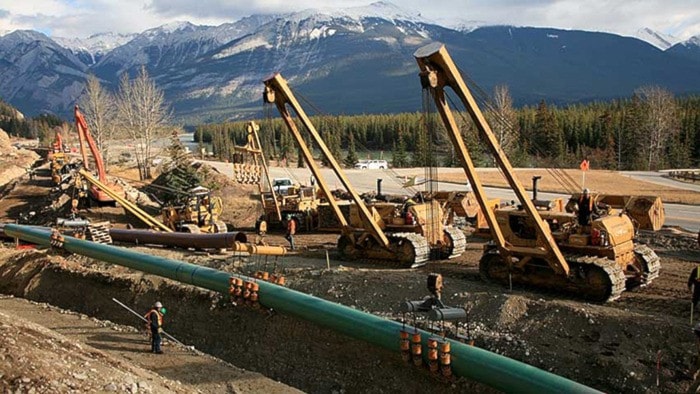Langley’s Salmon River Enhancement Society made its case regarding the Trans Mountain Pipeline expansion during a 40-minute presentation to the National Energy Board on Jan. 23.
The local environmental group was one of several intervenors to speak at the hearings, held in Burnaby Jan. 19-29.
“I think we got our points across,” SRES director Annabel Young told the Times, following their delegation.
“We just really want the National Energy Board to put some real value into the environmental impacts and what’s going to happen. They need to really pay attention to that, especially because climate around the world is becoming more and more important and people are more aware of it.”
Young and biologist Dr. Marvin Rosenau spoke to the NEB about the environmental impacts of twinning Kinder Morgan’s 1,150 km Trans Mountain oil pipeline from Edmonton to Burnaby.
In Langley, the pipeline will affect the Salmon River, West Creek, Nathan Creek and Yorkson Creek. Many of these areas still have not fully recovered from construction of the first pipeline in 1953, said Rosenau, who was hired by SRES to conduct scientific research using a $12,000 grant from the NEB.
“The edge habitats of the streams, all the brush and trees and salmon berry bushes and ferns, they’re all missing,” Rosenau said.
“Those are critical parts of fish habitat along stream edges. It’s missing in virtually all of the (pipe) crossings.”
Part of this problem could be mitigated by installing pipe with “trenchless technology,” such as directional drilling. By pushing the pipe below the stream, “you don’t mess up all the vegetation, you don’t mess up the banks, you don’t mess up the gravel and cobbles and all of the good stuff that fish use,” Rosenau said.
With other methods, such as trench crossings, fish habitats are “basically destroyed” by workers cutting a gouge across the stream and using riprap — or large, sharp blasted rock — to control stream erosion, he added.
According to the Trans Mountain website, construction will incorporate the use of trenchless technologies in “select locations to minimize potential disruption or environmental impact.”
Rosenau also says Trans Mountain has not provided a compensation plan for the loss of second growth trees — some nearing 100 years old — in the 45-metre section that will be stripped to make way for construction equipment.
“The way the design is, we think this is going to be basically obliterated,” Rosenau said.
“Those features, those habitat attributes, really are going to be lost. And they’re not going to grow back in five years, they’re not going to grow back in 10 years or even 50 years.
“So in order to basically provide some sort of response, some sort of compensation, some sort of offset, what we suggest is that the proponent buys up land and puts it into a protective status.”
In some areas of Florida, for example, for every acre of wetland destroyed, the proponent must purchase another 40 acres to be preserved in a protected zone, Rosenau added.
But perhaps the most frustrating part about presenting the SRES scientific reports to the NEB, is the fact they have to conduct their own reports in the first place, Young said.
They believe the proponent’s scientific reports take an activist approach and are not objective.
“It’s in the interest of Trans Mountain to have provided good science reports so that the Energy Board can make decisions with their reports, and the reports of intervenors,” Young said.
“So what’s happened is it’s really been the intervenors’ expense, personal expense, and time and money — even though there was some funding — (to) put together mostly very, very good, very rigorous reports.”
SRES was not allowed to cross examine the Trans Mountain scientists, and could only access information through formal requests.
“I think the frustrating thing was the refusal of the National Energy Board to force the proponent, to force Trans Mountain, to answer the questions,” she said.
“We couldn’t really rigorously ask questions to Trans Mountain.”
In a letter to the Times, Kinder Morgan Canada (KMC) president Ian Anderson said KMC has completed “years of planning, scientific studies and meaningful consultation.”
“The input and feedback we’ve gathered has created a stronger, safer and more responsive project. Safety is the cornerstone of everything we do, and our team has carefully developed measures to protect the health of our workers, communities and ecosystems,” Anderson wrote.
“And, 89 per cent of the proposed pipeline expansion parallels existing pipeline or utility infrastructure, minimizing community impacts.”
Anderson said Langley residents will see “significant benefits” should the expansion be approved, with the municipality collecting an additional $575,000 in taxes.
Phase two of the NEB hearings continued in Calgary last week.
